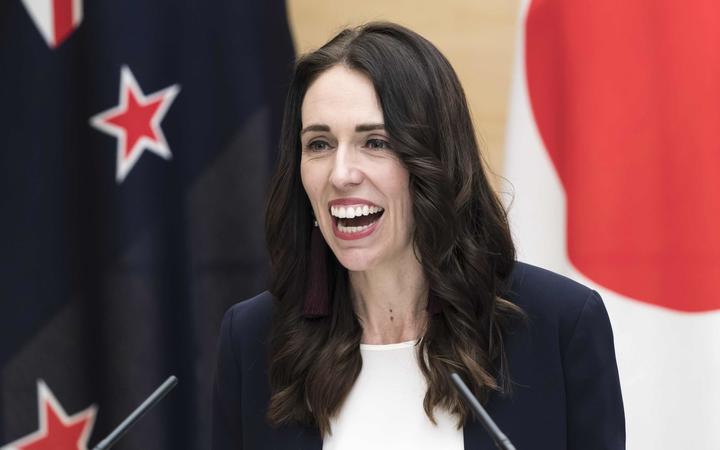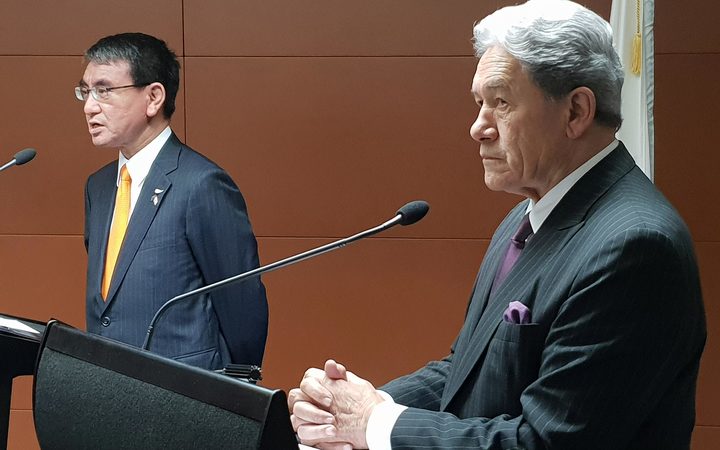As New Zealand's very successful Olympic campaign in Tokyo draws to a close, it's easy to be equally positive and optimistic about the state of New Zealand's wider relationship with Japan.

Prime Minister Jacinda Ardern speaking during a joint press conference with Japan's Prime Minister Shinzo Abe in Tokyo on September 19, 2019. Photo: AFP / Pool
If New Zealand's trading relationships were Olympic sports, Japan would miss out on a medal - but not by much.
Japan is New Zealand's fifth-biggest trading partner - behind only China, Australia, the US and the EU.
There is a healthy trade surplus in New Zealand's favour.
Fruit, dairy and aluminium currently top the list of New Zealand's exports, while tourism and education were also strong contributors before Covid-19.
In exchange, Japan's exports to New Zealand are dominated by vehicles.
The trading relationship is set to only strengthen over time, as phased-in benefits gradually accrue under the Comprehensive and Progressive Agreement for Trans-Pacific Partnership (CPTPP).
For example, tariffs on New Zealand beef exports will gradually fall to 9 percent by 2033 - from a hefty 38.5 percent.
READ MORE
- Fall in imports, healthy exports leads to trade milestone
- Sentiments and statistics: why CANZUK won’t fly
- 'Still no link between New Zealand meat and COVID': Govt confident NZ meat safe
- Negotiations on the UK's Future Trading Relationship with New Zealand
Tariffs on nearly all cheeses will be eliminated entirely, as will those on seafood.
Even before these gains, the Japan relationship was one of New Zealanders' absolute favourites.
In the latest 'Perceptions of Asia' survey by the Asia New Zealand Foundation, released in June, 71 percent of respondents thought Japan was friendly towards New Zealand.
It was the most popular Asian and non-English speaking country - by a considerable margin.
The next countries on the list, Germany and South Korea, received 'friendliness' scores of 59 percent and 51 percent respectively.
A long tradition of sporting and cultural exchanges goes some way to explaining the positive sentiment towards Japan.
Simon Draper, the head of the Asia New Zealand Foundation, points to working holiday visas, a heavy New Zealand involvement in Japan's JET English teacher programme and a long list of sister city relationships as just some of the driving factors.
Rugby diplomacy also helps.
Prime Minister Jacinda Ardern, finance minister Grant Robertson and then foreign minister Winston Peters all made largely successful official visits to Japan in 2019 to coincide with the country's hosting of the Rugby World Cup.
A rare diplomatic gaffe by Ardern - when she said China instead of Japan - did not appear to cause any longer-lasting damage.

The foreign ministers of Japan and New Zealand, Taro Kono and Winston Peters Photo: RNZ
Peters was even invited back to Japan as a special guest of the G20 foreign ministers' meeting, held a month later.
Japanese popular culture serves as the background theme music to the relationship.
David Capie, who wrote a report on the New Zealand-Japan relationship for the Asia New Zealand Foundation in 2019, pointed to the rise of Japanese culture in New Zealand from the 1980s onwards - including karaoke, manga, Pokemon and sushi.
In his view, Japan is a 'soft power superpower'.
People-to-people ties between New Zealand and Japan have also played a major role.
Jacinda Ardern herself is a good example - she learned Japanese and hosted a Japanese exchange student when she was at school.
From the New Zealand perspective, the last few years have also largely neutralised two main areas of tension - trade and whaling.
Japan's decision to join the CPTPP, which came into force at the end of 2018, resolved major differences over trade.
Whaling has also ceased to be the obstacle it once was, after Japan stopped hunting whales in the Southern Ocean in 2018.
But New Zealand's relationship with Japan might be about to become a lot more complicated.
Under Shinzo Abe, Japan's Prime Minister from 2012-2020, Japan sought to become a bigger global player.
Abe's surprise decision to join the Trans-Pacific Partnership (TPP) negotiations in 2013 - against fierce domestic opposition - was one of the first signs of this new engagement.
Another came in 2015, when the Japanese parliament voted - despite widespread public protests - to allow the country's military to fight overseas, provided certain conditions were met.
The move had previously been unthinkable, thanks to Japan's war-renouncing pacificist constitution that came into force in 1947.
Abe even tried - but ultimately failed - to change the constitution itself.
Tokyo's relationship with Beijing might have been expected to deteriorate as a result of Abe's policies.
After all, Abe was also the architect of the "free and open Indo-Pacific" doctrine - later enthusiastically adopted by Australia and the US - that can only be understood as a direct challenge to China's dominance in the region.
But surprisingly, China-Japan relations gradually improved over Abe's tenure.
Abe got on surprisingly well at a personal level with Chinese President Xi Jinping - who, like Abe, took office in 2012.
Regular high-level exchanges helped to smooth over tensions. Abe made an official visit to China in 2018 and even invited Xi to Japan for a highly symbolic state visit (Abe left office before the visit could take place).
Essentially, Abe adopted the "tightrope" approach of keeping both the West and China happy.
It is a strategy that New Zealand itself is very familiar with.
But Japan now has a new Prime Minister - and the country's relations with China are deteriorating.

Japan's Prime Minister Yoshihide Suga. Photo: AFP
Yoshihide Suga, Japan's new leader, lacks the personal rapport that Abe had with Xi - and he appears to be charting a more confrontational course.
Last month, an annual white paper from Japan's defence ministry focused on China as its main national security threat. For the first time, it also warned of a crisis over Taiwan.
Another overt signal - or a very unfortunate gaffe - came in June, when Suga angered Beijing by calling Taiwan a country.
Suga has aligned Japan even more closely with the US's recent more hardline position on China.
After a rare joint visit by the US Secretary of Defence and Secretary of State to Tokyo in March, a joint statement by the US and Japan explicitly addressed "China's behaviour" in no uncertain terms and stressed the US's "unwavering commitment" to defending Japan.
To underline the point, the statement specifically backed Japan's claim to the disputed Senkaku/Diaoyu Islands in the East China Sea.
Also in March, Suga joined the inaugural leaders' summit of the Quadrilateral Security Dialogue (or 'Quad' for short) with his counterparts from Australia, India and the US.
While Abe himself had revived the Quad, this was the first time it had been held at the leader level. It was another highly symbolic challenge to China.
Where do these changes leave New Zealand?
Since the CPTPP was signed, the Japanese-New Zealand relationship has been almost too good to be true.
But if Tokyo continues to take a firmer line on China and becomes more interested in "hard power" defence issues, this may make New Zealand's own relationship with Japan trickier.
The relationship would inevitably end up focusing on much more than just trade and people-to-people ties.
Trade might end up being linked or combined with other, more uncomfortable issues.
In this regard, there are early signs that New Zealand is reading the room.
At conferences in July, Jacinda Ardern and foreign minister Nanaia Mahuta both signalled that New Zealand might be interested in a 'Quad-plus' arrangement, alongside Australia, India, Japan and the United States.
It remains to be seen exactly what form any cooperation would take.
Tokyo 2020 is coming to an end.
But the real games might be just beginning.
*Geoffrey Miller is the Democracy Project's international analyst and writes on current New Zealand foreign policy and related geopolitical issues.





